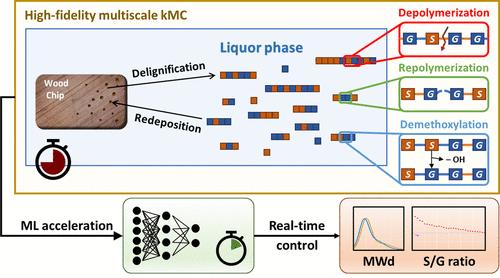当前位置:
X-MOL 学术
›
Ind. Eng. Chem. Res.
›
论文详情
Our official English website, www.x-mol.net, welcomes your
feedback! (Note: you will need to create a separate account there.)
Real-Time Model Predictive Control of Lignin Properties Using an Accelerated kMC Framework with Artificial Neural Networks
Industrial & Engineering Chemistry Research ( IF 3.8 ) Pub Date : 2024-11-19 , DOI: 10.1021/acs.iecr.4c02918 Juhyeon Kim, Jiae Ryu, Qiang Yang, Chang Geun Yoo, Joseph Sang-II Kwon
Industrial & Engineering Chemistry Research ( IF 3.8 ) Pub Date : 2024-11-19 , DOI: 10.1021/acs.iecr.4c02918 Juhyeon Kim, Jiae Ryu, Qiang Yang, Chang Geun Yoo, Joseph Sang-II Kwon

|
While lignin has garnered significant research interest for its abundance and versatility, its complicated structure poses a challenge to understanding its underlying reaction kinetics and optimizing various lignin characteristics. In this regard, mathematical models, especially the multiscale kinetic Monte Carlo (kMC) method, have been devised to offer a precise analysis of fractionation kinetics and lignin properties. The kMC model effectively handles the simulation of all particles within the system by calculating reaction rates between species and generating a rate-based probability distribution. Then, it selects a reaction to execute based on this distribution. However, due to the vast number of lignin polymers involved in the reactions, the rate calculation step becomes a computational bottleneck, limiting the model’s applicability in real-time control scenarios. To address this, the machine learning (ML) technique is integrated into the existing kMC framework. By training an artificial neural network (ANN) on the kMC data sets, we predict the probability distributions instead of repeatedly calculating them over time. Subsequently, the resulting ANN-accelerated multiscale kMC (AA-M-kMC) model is incorporated into a model predictive controller (MPC), facilitating real-time control of intricate lignin properties. This innovative approach effectively reduces the computational burden of kMC and advances lignin processing methods.
中文翻译:

使用带有人工神经网络的加速 kMC 框架对木质素特性进行实时模型预测控制
虽然木质素因其丰富性和多功能性而引起了研究兴趣,但其复杂的结构对理解其潜在的反应动力学和优化各种木质素特性构成了挑战。在这方面,已经设计了数学模型,尤其是多尺度动力学蒙特卡洛 (kMC) 方法,以提供对分馏动力学和木质素特性的精确分析。kMC 模型通过计算物质之间的反应速率并生成基于速率的概率分布,有效地处理系统内所有粒子的模拟。然后,它会根据此分布选择要执行的反应。然而,由于反应中涉及大量的木质素聚合物,速率计算步骤成为计算瓶颈,限制了模型在实时控制场景中的适用性。为了解决这个问题,机器学习 (ML) 技术被集成到现有的 kMC 框架中。通过在 kMC 数据集上训练人工神经网络 (ANN),我们可以预测概率分布,而不是随着时间的推移重复计算它们。随后,所得的 ANN 加速多尺度 kMC (AA-M-kMC) 模型被整合到模型预测控制器 (MPC) 中,从而有助于实时控制复杂的木质素特性。这种创新方法有效地减轻了 kMC 的计算负担并推进了木质素加工方法。
更新日期:2024-11-19
中文翻译:

使用带有人工神经网络的加速 kMC 框架对木质素特性进行实时模型预测控制
虽然木质素因其丰富性和多功能性而引起了研究兴趣,但其复杂的结构对理解其潜在的反应动力学和优化各种木质素特性构成了挑战。在这方面,已经设计了数学模型,尤其是多尺度动力学蒙特卡洛 (kMC) 方法,以提供对分馏动力学和木质素特性的精确分析。kMC 模型通过计算物质之间的反应速率并生成基于速率的概率分布,有效地处理系统内所有粒子的模拟。然后,它会根据此分布选择要执行的反应。然而,由于反应中涉及大量的木质素聚合物,速率计算步骤成为计算瓶颈,限制了模型在实时控制场景中的适用性。为了解决这个问题,机器学习 (ML) 技术被集成到现有的 kMC 框架中。通过在 kMC 数据集上训练人工神经网络 (ANN),我们可以预测概率分布,而不是随着时间的推移重复计算它们。随后,所得的 ANN 加速多尺度 kMC (AA-M-kMC) 模型被整合到模型预测控制器 (MPC) 中,从而有助于实时控制复杂的木质素特性。这种创新方法有效地减轻了 kMC 的计算负担并推进了木质素加工方法。


















































 京公网安备 11010802027423号
京公网安备 11010802027423号